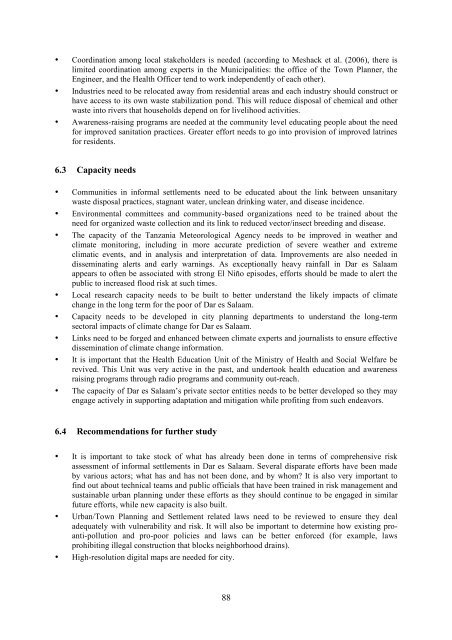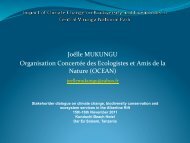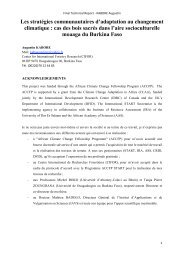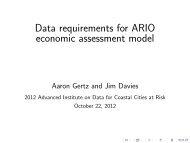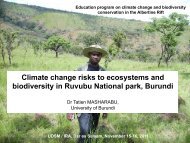Urban Poverty & Climate Change in Dar es Salaam, Tanzania:
Urban Poverty & Climate Change in Dar es Salaam, Tanzania:
Urban Poverty & Climate Change in Dar es Salaam, Tanzania:
Create successful ePaper yourself
Turn your PDF publications into a flip-book with our unique Google optimized e-Paper software.
• Coord<strong>in</strong>ation among local stakeholders is needed (accord<strong>in</strong>g to M<strong>es</strong>hack et al. (2006), there is<br />
limited coord<strong>in</strong>ation among experts <strong>in</strong> the Municipaliti<strong>es</strong>: the office of the Town Planner, the<br />
Eng<strong>in</strong>eer, and the Health Officer tend to work <strong>in</strong>dependently of each other).<br />
• Industri<strong>es</strong> need to be relocated away from r<strong>es</strong>idential areas and each <strong>in</strong>dustry should construct or<br />
have acc<strong>es</strong>s to its own waste stabilization pond. This will reduce disposal of chemical and other<br />
waste <strong>in</strong>to rivers that households depend on for livelihood activiti<strong>es</strong>.<br />
• Awaren<strong>es</strong>s-rais<strong>in</strong>g programs are needed at the community level educat<strong>in</strong>g people about the need<br />
for improved sanitation practic<strong>es</strong>. Greater effort needs to go <strong>in</strong>to provision of improved latr<strong>in</strong><strong>es</strong><br />
for r<strong>es</strong>idents.<br />
6.3 Capacity needs<br />
• Communiti<strong>es</strong> <strong>in</strong> <strong>in</strong>formal settlements need to be educated about the l<strong>in</strong>k between unsanitary<br />
waste disposal practic<strong>es</strong>, stagnant water, unclean dr<strong>in</strong>k<strong>in</strong>g water, and disease <strong>in</strong>cidence.<br />
• Environmental committe<strong>es</strong> and community-based organizations need to be tra<strong>in</strong>ed about the<br />
need for organized waste collection and its l<strong>in</strong>k to reduced vector/<strong>in</strong>sect breed<strong>in</strong>g and disease.<br />
• The capacity of the <strong>Tanzania</strong> Meteorological Agency needs to be improved <strong>in</strong> weather and<br />
climate monitor<strong>in</strong>g, <strong>in</strong>clud<strong>in</strong>g <strong>in</strong> more accurate prediction of severe weather and extreme<br />
climatic events, and <strong>in</strong> analysis and <strong>in</strong>terpretation of data. Improvements are also needed <strong>in</strong><br />
dissem<strong>in</strong>at<strong>in</strong>g alerts and early warn<strong>in</strong>gs. As exceptionally heavy ra<strong>in</strong>fall <strong>in</strong> <strong>Dar</strong> <strong>es</strong> <strong>Salaam</strong><br />
appears to often be associated with strong El Niño episod<strong>es</strong>, efforts should be made to alert the<br />
public to <strong>in</strong>creased flood risk at such tim<strong>es</strong>.<br />
• Local r<strong>es</strong>earch capacity needs to be built to better understand the likely impacts of climate<br />
change <strong>in</strong> the long term for the poor of <strong>Dar</strong> <strong>es</strong> <strong>Salaam</strong>.<br />
• Capacity needs to be developed <strong>in</strong> city plann<strong>in</strong>g departments to understand the long-term<br />
sectoral impacts of climate change for <strong>Dar</strong> <strong>es</strong> <strong>Salaam</strong>.<br />
• L<strong>in</strong>ks need to be forged and enhanced between climate experts and journalists to ensure effective<br />
dissem<strong>in</strong>ation of climate change <strong>in</strong>formation.<br />
• It is important that the Health Education Unit of the M<strong>in</strong>istry of Health and Social Welfare be<br />
revived. This Unit was very active <strong>in</strong> the past, and undertook health education and awaren<strong>es</strong>s<br />
rais<strong>in</strong>g programs through radio programs and community out-reach.<br />
• The capacity of <strong>Dar</strong> <strong>es</strong> <strong>Salaam</strong>’s private sector entiti<strong>es</strong> needs to be better developed so they may<br />
engage actively <strong>in</strong> support<strong>in</strong>g adaptation and mitigation while profit<strong>in</strong>g from such endeavors.<br />
6.4 Recommendations for further study<br />
• It is important to take stock of what has already been done <strong>in</strong> terms of comprehensive risk<br />
ass<strong>es</strong>sment of <strong>in</strong>formal settlements <strong>in</strong> <strong>Dar</strong> <strong>es</strong> <strong>Salaam</strong>. Several disparate efforts have been made<br />
by various actors; what has and has not been done, and by whom? It is also very important to<br />
f<strong>in</strong>d out about technical teams and public officials that have been tra<strong>in</strong>ed <strong>in</strong> risk management and<br />
susta<strong>in</strong>able urban plann<strong>in</strong>g under th<strong>es</strong>e efforts as they should cont<strong>in</strong>ue to be engaged <strong>in</strong> similar<br />
future efforts, while new capacity is also built.<br />
• <strong>Urban</strong>/Town Plann<strong>in</strong>g and Settlement related laws need to be reviewed to ensure they deal<br />
adequately with vulnerability and risk. It will also be important to determ<strong>in</strong>e how exist<strong>in</strong>g proanti-pollution<br />
and pro-poor polici<strong>es</strong> and laws can be better enforced (for example, laws<br />
prohibit<strong>in</strong>g illegal construction that blocks neighborhood dra<strong>in</strong>s).<br />
• High-r<strong>es</strong>olution digital maps are needed for city.<br />
88


